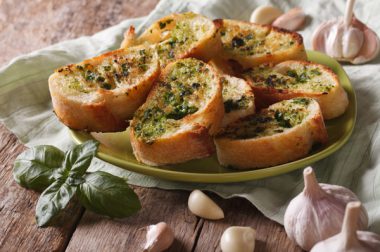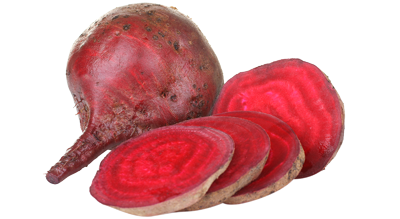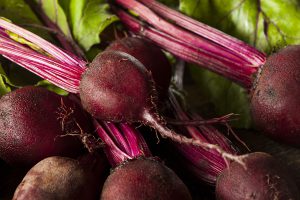Recipes we love
See all recipesPeppermint beetroot
This recipe can also be prepared with raw beetroots. Just grate them, using the large part of a chee...
Chicory and beetroot salad
A fresh, tasty and light salad, ideal for summer meals to share with friends or family. A starter fu...
Beetroot with horseradish
Vegetables really like spicy seasoning: it gives them just the right boost in flavour to win over ev...
IS BEETROOT GOOD
FOR YOUR HEALTH?
It blushes for our well-being
Beetroot is mainly distinguished by its red color. The different pigments in beetroot are thought to contain substances with antioxidant properties. Its flavonoid content is constant, even after cooking. This means that beetroot is one of the rare vegetables to contain betalains, to which it owes its marked red color…which stains!
Beetroot is also a source of :
- Vitamin C, which is a very important vitamin, as it regulates the immune system, helps the nervous system to function properly, can reduce fatigue and protects the body against oxidative stress
- Vitamin B9, which is important for cellular renewal, particularly important for fetal development during pregnancy, for immunity, and for psychological functioning
- Fiber
NUTRITIONAL
COMPOSITION
WHEN IS THE RIGHT
TIME TO EAT IT?
Beetroot is eaten throughout the year.
Cooked, beetroot is available year-round. Raw, it is in season from May through October.
VEGETABLE PATCH
OR URBAN BALCONY?
Beetroot thrives in sunny spots and cool, light, deep soil that is rich in humus. When should you harvest it? From mid-July until the first frosts of fall.
To learn everything you need to know about growing beetroot, read the page on growing advice.
CHOOSING
AND STORING BEETROOT
Choose your beetroot well :
- When raw, the skin should still be slightly moist.
- When cooked, the skin should be smooth and not dried out.
Store your beetroot properly :
- Raw and cooked beetroot should be stored in the vegetable drawer of the refrigerator, in an airtight package or a bag.
- Eat four to five days after purchasing. It will last longer if you purchase vacuum-packed beetroot.
ANTI-WASTE TIPS
Don’t throw away the leaves of beetroot – think about your health, and that of the planet! Even the leaves are good for you. They are also edible and contain valuable antioxidants, lutein and zeaxanthin. Pan-fry them in shallot oil (frying the stalks first). While they are still hot, serve with a fromage blanc, orange and horseradish sauce.
You can also make a pesto with the leaves! Wash them, and then mix with some pine nuts, Parmesan and olive oil.
WHAT IS THE ENVIRONMENTAL IMPACT?
The Product Environmental Footprint (PET) tells us more! This is a score, calculated by Agribalyse*, which takes into account all of the stages of a vegetable’s life cycle: how it is grown, the impact of transport and processing, and so on. The lower the score, the lower the environmental impact.
- Beetroot, raw: 0.06
- Beetroot, cooked: 0.11
- Beetroot juice: 0,15
- Beefsteak, raw: 0.15
*Data taken from the Agribalyse database, which records the environmental score of food items. This unique score is an average of 16 indicators, calculated according to the European PEF methodology. It does not correspond to an environmental label or “eco-score”.
CO2 equivalent: For 100 g of raw beetroot: 0.037 kg of CO2e, which is the same as 1.3 g of raw beefsteak.
Beetroot juice not only has a higher environmental score than raw beetroot, but it contains less than half of the fiber.
TIPS
AND TRICKS
How to cook beetroot
If you want to cook your beetroot yourself, be patient! Count on cooking it in boiling water with salt and vinegar for around two and a half hours.
It will cook faster in the oven (one hour at 180°C) or when steamed (25 to 30 minutes). When the skin comes off easily, the beetroot is fully cooked.
Beetroot goes well with…
Cooked beetroot is the main ingredient of the famous borschts of Eastern Europe. In Russia, people cook a red soup using beetroot and chicken broth, embellished with croutons and crème fraîche. It is a mild and balanced meal.
Cooked beetroot (and grated raw beetroot) go well with hardboiled eggs and lettuce in a vinaigrette, and with fresh cheese, goat cheese, apples, endives, and lamb’s lettuce.
Blended beetroot soups are also delicious. The vegetable is also tasty cooked in a sauté with oil and onion! It works best as a side dish with game, fish, and poultry.
Anti-stain tip: Cover a beetroot stain on cotton fabric with ammonia before washing. For more delicate fabrics, allow them to soak in water with laundry detergent for around an hour. Then cover the stain in white vinegar and put it in the washing machine.
Try it out! Some chefs combine beetroot with cherries, for a range of red hues and a marriage of the sweet taste of beetroot and the tart cherries.
CAN PEOPLE
OF ALL AGES EAT IT?

Young children
You can offer beetroot to children as soon as they begin to eat solid food. Offering a red and sweet beetroot purée is an excellent way to vary tastes and colors. It is scientifically proven that varying a child’s diet as soon as solid foods are introduced makes it easier to introduce new foods.
And everyone else
Beetroot is easy to eat cooked and is well liked by people with delicate palates, no matter their age.
See plenty of other tips for encouraging children to eat vegetables
WHERE DOES IT
COME FROM?
Origins
Europe (France, Poland, and the United Kingdom) and the United States are the two main beetroot producers. It can also be found in Quebec.
Varieties
The two most common varieties are the globe-shaped Detroit Dark Red, whose root is round and smooth with a dark red interior, and the Crosby Egyptian, even rounder and smoother. There are also long varieties (Crapaudine), pink varieties, (Di Chioggia) and varieties verging on white (Albina Vereduna).



 Millet
Millet  Chickpeas
Chickpeas  Vegetable garden: sweet potato
Vegetable garden: sweet potato 










